There are a few people still around
who remember the good old days–the days of taking a weekend ride on
an open-air trolley, the warm breeze hitting them in the face, as
they rolled along at seven miles an hour toward an earthly paradise
known as the trolley park.
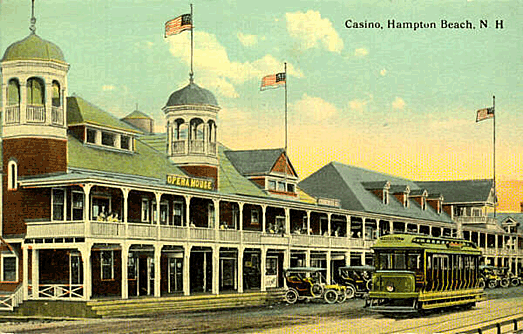
These urban-weary people came to enjoy leisurely strolls through the
woods, or perhaps a quiet boat ride for two on a placid lake. Some
came to take in band concerts, play croquet games on the spacious
lawns, or picnic in the rustic woodlands far from the soot and grime
of their town or city. Young married couples who courted on Sunday
rail trips to these parks, soon brought their children, for trolley
parks were a family affair, a reflection of the wholesome atmosphere
of turn-of-the-century society.
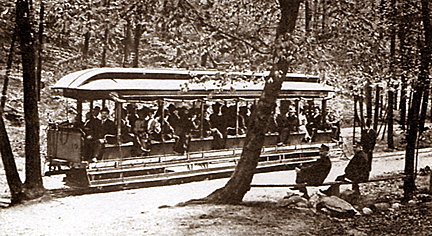 Prior
to the Great Depression of 1929, there were more than 1,000 of these
parks in the U.S. A trip to a trolley park back then cost 15-25
cents. Some were simply a picnic grove with an athletic field and
swimming area. Others were full-fledged amusement parks with a
variety of rides, games, dance halls and roller skating rinks. The
rail companies built many of the parks themselves, usually at one
end of a rail line, to generate passenger traffic on the weekends.
Prior
to the Great Depression of 1929, there were more than 1,000 of these
parks in the U.S. A trip to a trolley park back then cost 15-25
cents. Some were simply a picnic grove with an athletic field and
swimming area. Others were full-fledged amusement parks with a
variety of rides, games, dance halls and roller skating rinks. The
rail companies built many of the parks themselves, usually at one
end of a rail line, to generate passenger traffic on the weekends.
Since electric companies charged the trolley owners a flat rate for
their electricity, regardless of actual consumption, the trolley
companies wanted to encourage people to travel on weekends since
their heaviest ridership occurred during the weekdays. So they built
picnic groves near bodies of water at the end of their trolley
lines. As more weekend picnickers traveled on the trolley line, the
companies added more attractions to their parks.
These early parks, tame by Coney Island standards, catered to
church-going, family- oriented city dwellers. By the early 1900s,
every major U.S. city had at least one trolley park. Originally just
picnic groves with a band pavilion and perhaps a boat ride, these
parks expanded to include a carousel, a Ferris wheel, a roller
coaster, a penny arcade, and a fireworks display by 1910. Other
attractions included band concerts, balloon ascensions, and dance
halls.
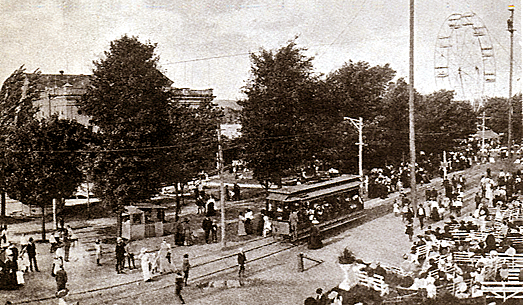
The idea of public amusement parks,
places where people could go for a short time to enjoy themselves
and forget their daily problems, began in Europe in the early 19th
century. In 1873 at the World's Fair in Vienna, Austria, people from
around the globe experienced the thrill of riding a primitive Ferris
wheel, an updated version of the carousel, and the "Russian
Mountains," a two person car that rolled from a high platform down a
track to its stopping point–one of the first roller coasters. These
rides became so popular that improved versions as well as new kinds
of thrilling rides quickly appeared in trolley parks across the U.S.
For those who ran the trolley lines, amusement parks located at the
end of their tracks became a money-making opportunity. The trolley
companies not only had a way to get people to their parks but also
had access to tremendous amounts of electricity needed to operate
the rides. City and suburban railway companies, realizing the profit
arising by catering to the pleasure of the masses, entered into the
amusement field on an extensive scale. Except for the nickel, dime
or quarter which admitted visitors to concerts, offered an hour’s
boat rental, or provided some other special amusement, trolley parks
were free to all.
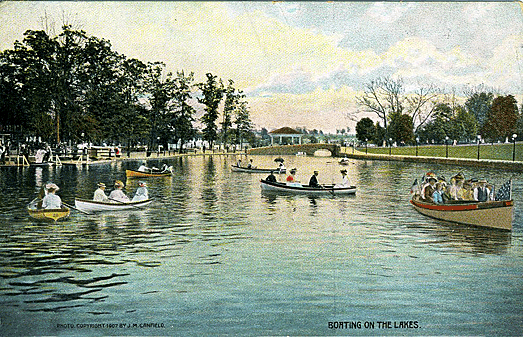
Initially, the parks consisted of
peaceful gardens, a small lake and a picnic grove. Soon companies
added entertainment pavilions, theaters and ballrooms. As time
passed, they added rides. One of earliest was the carousel,
originally an adult ride. Visitors could also try Shoot the Chute,
ride on a miniature railroad or on an early roller coaster.
The people of Philadelphia were luckier than most. Within the area
surrounding the city were four trolley parks: Woodside Park, the
closest on the fringe of Fairmount Park; Point Breeze Park, the last
to be established and the first to expire; Erdenheim, a smaller park
in the northern suburb of Chestnut Hill; and Willow Grove, the
largest and most successful to the northwest of the city.
None could compare in size and importance with Willow Grove Park. At
its peak, such noted publications as the Street Railway Journal
looked on it as a model of what the properly operated park should
be. Its importance was such that it inspired many similar parks
throughout the country.
Willow Grove had over 100 amusement concessions by 1905. In addition
to these rides, the park management provided concerts, an electric
fountain with colored lights, and a fireworks display on special
occasions such as the Fourth of July.
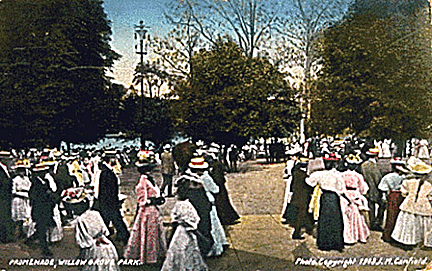 Visitors
to Willow Grove could boat on the park’s largest lake, which covered
an area of four acres–an electric launch and rowboats were available
for rental. Over 50,000 electric lights, including incandescent
lighting inside the buildings and arc lights for the illumination of
paths and picnic areas, illuminated the park at night. It even had a
small hospital with a full-time physician.
Visitors
to Willow Grove could boat on the park’s largest lake, which covered
an area of four acres–an electric launch and rowboats were available
for rental. Over 50,000 electric lights, including incandescent
lighting inside the buildings and arc lights for the illumination of
paths and picnic areas, illuminated the park at night. It even had a
small hospital with a full-time physician.
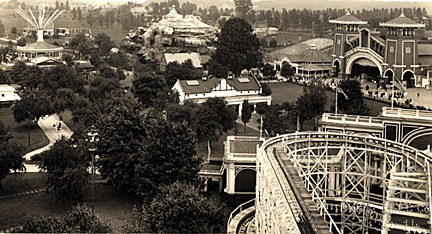 The
most spectacular ride was the roller coaster, which had a corporate
structure as spectacular as the ride itself. When it was originally
constructed in 1904-1905, it was classified as a railroad. Since the
articles of incorporation of the Philadelphia Rapid Transit Company
(PRT) permitted it to operate railroads but not to build them, the
PRT created a wholly-owned dummy corporation, the L. A. Thompson
Mountain Railway Company, to build it. This was probably the only
roller coaster ever built with its own corporation. The mountain
railway operated trains instead of individual cars as most amusement
parks. It had an engineer with each train and block signaling along
the route. A toboggan ride stood at the other end of the Midway.
The
most spectacular ride was the roller coaster, which had a corporate
structure as spectacular as the ride itself. When it was originally
constructed in 1904-1905, it was classified as a railroad. Since the
articles of incorporation of the Philadelphia Rapid Transit Company
(PRT) permitted it to operate railroads but not to build them, the
PRT created a wholly-owned dummy corporation, the L. A. Thompson
Mountain Railway Company, to build it. This was probably the only
roller coaster ever built with its own corporation. The mountain
railway operated trains instead of individual cars as most amusement
parks. It had an engineer with each train and block signaling along
the route. A toboggan ride stood at the other end of the Midway.
Willow Grove’s visitors never had to worry about eating. The Park
had plenty of refreshment stands, plus a restaurant called The
Casino located directly in front of the music pavilion, where up to
500 persons could be served at one time on the open porches, while
they listened to the music from the pavilion. The PRT operated the
restaurant, unlike most of the concessions, and maintained high
standards, with prices to match. In between concerts, small musical
groups played dinner music.
In addition, the Park offered two cafes, one in the upper part of
the Park near the amusements, and one in the lower part, overlooking
the lake and the electric fountain. A soda fountain was popular with
visitors, as were the three picnic groves, on the outer edge of the
Park. Plus, there was a candy store, known as Candyland.
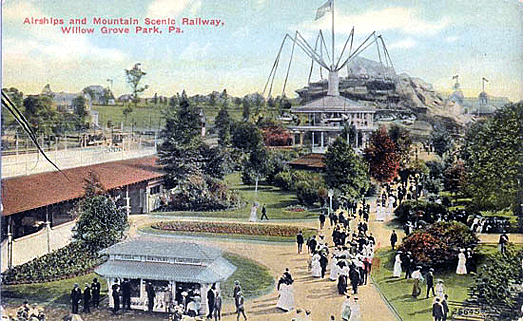
Willow Grove’s major amusements–the
Old Mill, the St. Nicholas Colliery, a representation of a coal
mine, the Venice exhibit, which gave visitors a canal ride through a
faithful reproduction of Venice, and the Willowgraph Theater–stood
between the toboggan and the Mountain Railway. Smaller exhibits
included a photograph gallery and a mirror maze, as well as an
exhibit entitled Tours of the World. The Park had not one, but two
carousels, located at each end of the Midway, and a Ferris Wheel.
To run such a large park took more than 500 workers during the
summer season. Largely self-sufficient, it had its own sewage
disposal plant and greenhouses.
Records indicate that Willow Grove, as with many other trolley
parks, wasn’t a financial success. Established to attract business
to the trolley lines, it took money to maintain it. Once it became
hugely successful, it took even more money to add trolley lines,
barns, drivers, etc. The biggest problem was the uneven crowds. In
the winter, those living nearby furnished most of the business.
During the summer, as many as 20,000 people could leave the Park in
30 minutes after the end of a concert. At its peak, equipment and
personnel from regular trolley lines had to be diverted to take care
of the huge crowds going to and from the park..
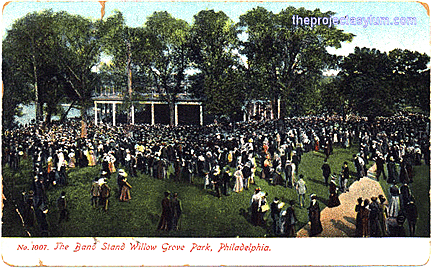 But
one thing at Willow Grove stood out from all other trolley parks.
The PRT management decided that the entertainment at the Park should
be of a cultural nature, a radical departure from the Coney Island
approach. In 1897, the PRT instituted regular music programs in the
Park, and hired the New York Symphony Orchestra, conducted by Walter
Damrosch, to come to Willow Grove and play the entire season.
Visitors loved this so much that musical presentations became Willow
Grove’s most noted attraction.
But
one thing at Willow Grove stood out from all other trolley parks.
The PRT management decided that the entertainment at the Park should
be of a cultural nature, a radical departure from the Coney Island
approach. In 1897, the PRT instituted regular music programs in the
Park, and hired the New York Symphony Orchestra, conducted by Walter
Damrosch, to come to Willow Grove and play the entire season.
Visitors loved this so much that musical presentations became Willow
Grove’s most noted attraction.
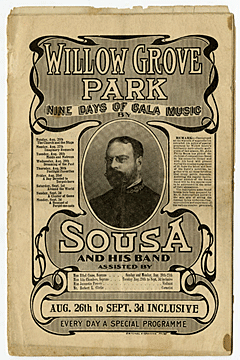 Soon,
however, patrons became bored with the same musical group, so the
PRT brought in various groups, such as the Chicago Marine Band,
Victor Herbert’s Orchestra, and the Royal Marine Band of Italy, for
shorter engagements. But the Park’s most famous performer was John
Philip Sousa, who eventually wrote many of his marches while playing
at the Park.
Soon,
however, patrons became bored with the same musical group, so the
PRT brought in various groups, such as the Chicago Marine Band,
Victor Herbert’s Orchestra, and the Royal Marine Band of Italy, for
shorter engagements. But the Park’s most famous performer was John
Philip Sousa, who eventually wrote many of his marches while playing
at the Park.
Like so many trolley parks, Willow Grove Park never recaptured the
splendor of the years prior to World War I and gradually declined in
prestige and prosperity after the PRT sold it to a private company.
The new company sold the northernmost picnic grove, greenhouses,
power house, and car barn, to real estate developers. They added new
rides and refurbished old ones to try to update the Park.
Some parks, like Glen Echo Amusement Park outside Washington, D.C.,
added dance halls, roller coasters, new carousels, bumper cars and
other rides. One of the features added at this park in the early
1930s was the Crystal Pool, built to accommodate 3,000 swimmers. It
was one of the largest in America with 1.5 million gallons of
circulating water. Two years later, the owners built the Spanish
Ballroom adjacent to the pool. And throughout the 1940s, they
constantly added more features, including two cafes and an arcade
building.
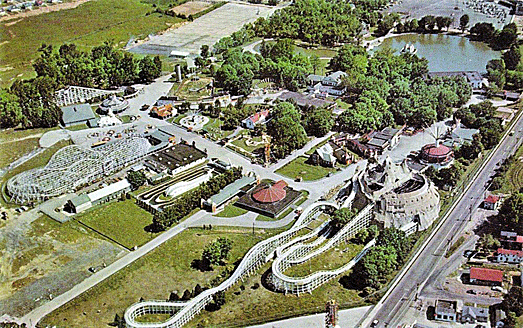
However, fire was always the biggest
danger to these trolley parks, especially in their later years.
A series of events put an end to the trolley parks. The Great
Depression, Prohibition, and a railroad strike put a strain on
trolley companies. The public abandoned the trolley lines for the
automobile. With the trolley lines closed, most of the parks closed
with them. Of the remaining parks, the majority lacked adequate
parking space. Also with automobiles, people no longer had to stay
within the confines of the trolley route system. Only those who
couldn’t afford cars came to the trolley parks. It wasn’t long
before criminals infested the remaining ones. So their owners had no
choice but to sell them off to real estate developers.
Pennsylvania hosts five of the dozen original trolley parks still in
existence today. Although each has been overhauled to adjust to the
times, all hold lasting memories for the thousands of people who
found pleasure at them. As for Willow Grove Park, it’s now the
Willow Grove Park Mall, a new type of amusement center for today’s
generation.
